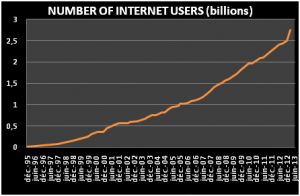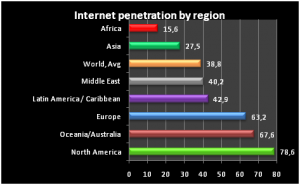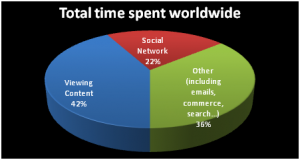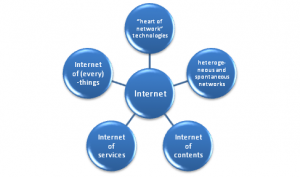TOP 10 POST: U0026QUOT;THE NEW FACES OF INTERNET (PART 1)U0026QUOT;
January 6, 2014
Over the holidays, we will repost the top ten most popular blog posts of the year. This is one:
Internet today
For many people it is hard to imagine life without internet. It fills our everyday’s life and it is the main medium for many people on all imaginable topic. However, only a minority of the population on our planet have access to it, even if the last decade matched with the boom of internet access, and the next decade will probably see this problem solved: as 28 years ago, only a few thousands users were enjoying it, today mid-2013, about 2.8 billions of people have internet access (38.8% population worldwide). And it is estimated that half of worldwide population might be connected on internet by 2015, and for the most optimistic, entire world will be online by 2020 (Google chairman, April 2013).
Source: internet world stats.
By focusing on Internet penetration rate by areas, we notice that North America is currently the region with the highest Internet penetration rate in the world (78.6%), followed by Oceania/Australia and Europe (63.2%), and only 15,6% for Africa.
Source: internet world stats.
Internet usage is evolving every month, going beyond “mainstream” usages such as email sending, web search, buying online, streaming movies or music, or social networking. Internet is no longer just a canal dedicated to transport data from one point to another (whatever the data are). Numerous fields of research are in progress on different domains of what we call globally “the internet”, leading to multiplicity of emergent needs. Let’s have a look at some of them:
Internet and “heart of network” technologies
“Heart of network” technologies are related to the physical infrastructure of internet. Historically, the internet infrastructure used existing wired telephone lines and wired networks; And more recently, optical fiber and electric lines (by using PLC -Power Line Communication-).
As for wireless networks, the evolution of their infrastructure knows today a huge development due also to mobile-broadband subscriptions which have climbed from 268 million in 2007 to 2.1 billion in 2013. This reflects an average annual growth rate of 40%, making mobile broadband the most dynamic ICT market. The capability to transmit always faster information data (which is richer and even more complex) between content providers and end-user terminals (PC, Smartphone, tablets, and soon other devices such as connected watches, glasses, gloves…) is one of the key factor of the success of internet. De facto, the conception and deployment of powerful data transport networks, sized to answer to growing needs of internet users, are a major challenge for industrials.
On a R&D point of view, a lot of efforts are currently being done to develop “heart of network” technologies on different ways:
– by developing more powerful radio communication links (100 Mbit/sec, 1 Gbit/sec, …) in order to increase wireless access to data speed.
– by looking for a better use of spectrum especially in the following contexts of:
- « Flexible » wireless communication: in order to allow dynamical software reconfiguration of wireless devices to let coexist inside a single device/chip several communication standards
- « Cognitive » wireless communication: in order to determine automatically available frequencies via a smart-antenna which scans wireless spectrum and selects the most adequate signals: A device will then be able to select an available network and migrate instantly its connection, without interfering with other users/devices using these frequencies.
- and « Auto-organisation » of miscellaneous access technologies (2G, 3G, LTE, Wifi, WiMax, Satellite…).
– by developing optical fiber technology to deploy it as closely as possible to internet users in order to increase quality of service (FTTx),
– Or by increasing wireless networks connectivity, creating new or optimized ways to transmit more data on exisiting wireless networks: e.g. Some Academic researchers have devised a way of boosting the performance of wireless networks by up to 10 times — without increasing transmission power, adding more base stations, or using more wireless spectrum, by using algebra to eliminate the network-clogging task of resending dropped packets of data.
“Heart of network” technologies are the backbone of internet: the R&D and innovations in this domain allow always better, faster, and pervasive connectivity and lead to emergence of new usages, thanks also to research and breakthrough innovations done in connected areas, because internet not only relies on data transmission, but also on capturing, storing, searching, sharing, analyzing and visualizing data.
My next blog’s articles will talk about the other faces of internet, stay tuned !

 English | EN
English | EN 



